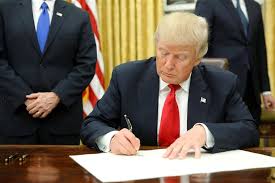
Legal observers believe a presidential permit signed last Friday by President Trump is a way to get around previous federal court orders halting development of the Keystone XL oil pipeline. His order would jump-start construction of the line that would eventually connect to the Cushing Hub and the already-in-place Keystone line in Oklahoma.
The permit authorizes energy company TransCanada Corp. to “construct, connect, operate, and maintain” pipeline facilities between the U.S. and Canada according to a report in The Hill.
The permit also allows for the maintenance of a pipeline facility at Phillips County, Montana, for importation of the oil to the U.S.
The order supersedes a March 2017 order. That permit was invalidated by a Montana federal judge in November. The ruling is being appealed in the 9th Circuit. Separately, a December lawsuit placed an injunction on most pre-construction activities.
“For the avoidance of doubt, I hereby revoke that March 23, 2017, permit,” Trump wrote in Friday’s order.
A White House spokesperson told The Hill that the new permit “dispels any uncertainty.”
“Specifically, this permit reinforces, as should have been clear all along, that the Presidential Permit is indeed an exercise of Presidential authority – that is not subject to judicial review under the Administrative Procedure Act,” the spokesperson added.
The pipeline has been a lightning rod in national energy policy for much of a decade since its proposal by TransCanada.
The November court ruling was seen as a major victory for environmentalists and indigenous rights groups. U.S. District Court Judge Brian Morris in Montana overturned Trump’s permit for the Canada-to-Texas pipeline.
Morris’s ruling faulted the Trump administration for reversing former President Obama’s 2015 denial of the pipeline permit without proper explanation. He said the State Department “simply discarded” climate change concerns related to the project.
The decision threw into doubt the future of the 1,179-mile Keystone XL pipeline that has been in commission since 2010.
The initial permit was also largely blocked because the court found issues with its environmental review.
In rejecting the permit, Morris relied mainly on arguing that the State Department, the agency that analyzed the project, didn’t properly account for factors such as low oil prices, the cumulative impacts of greenhouse gases from Keystone and the Alberta Clipper pipeline, and the risk of oil spills.
“The major spills that occurred between 2014 and 2017 qualify as significant. The department would have evaluated the spills in the 2014 [environmental review] had the information been available,” wrote Morris, whom Obama nominated to the court.
He ordered a new environmental review.
Trump’s new permit could potentially circumvent that issue.





